1993 CADILLAC SEVILLE instrument panel
[x] Cancel search: instrument panelPage 29 of 407
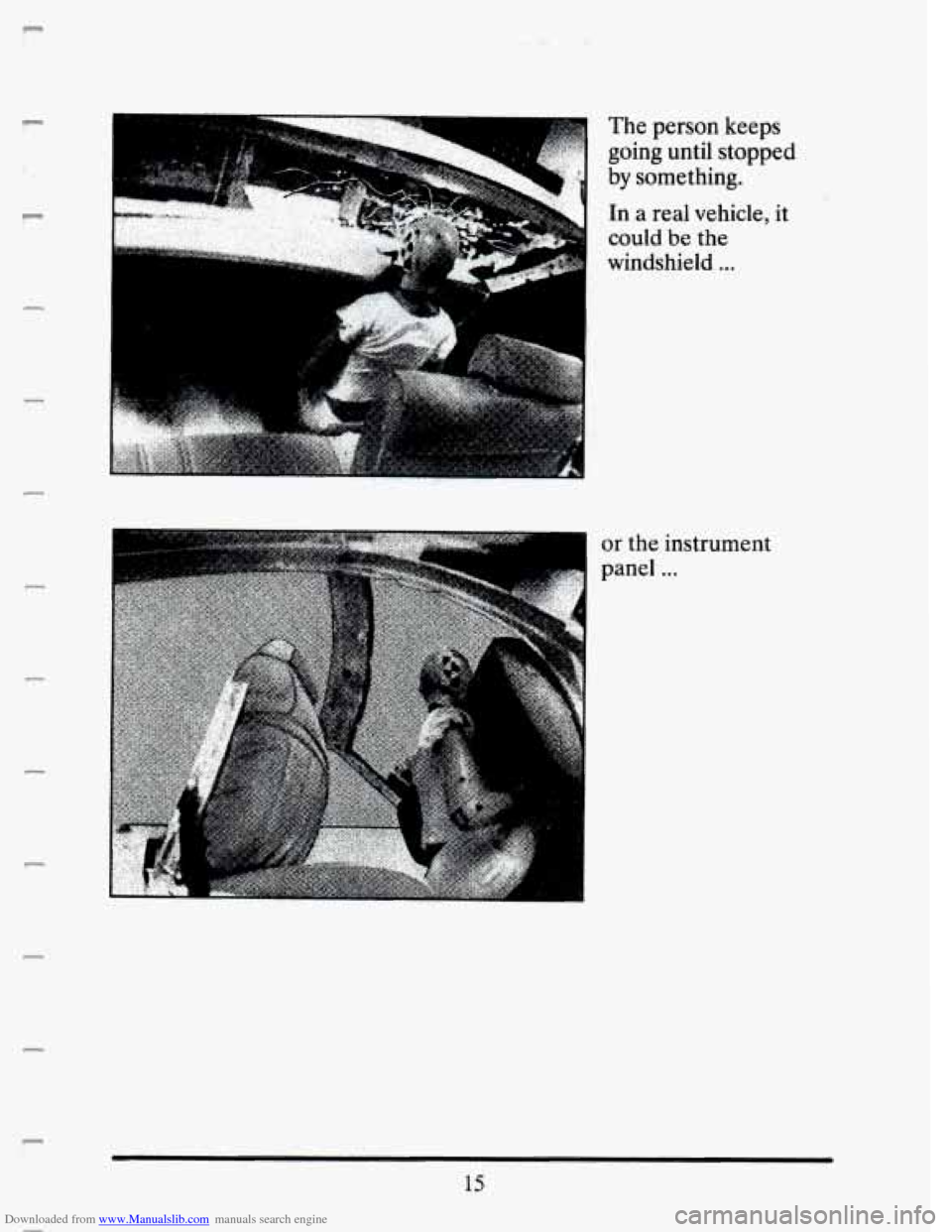
Downloaded from www.Manualslib.com manuals search engine F
F
L
C
c
The person keeps
going until stopped
by something.
In a real vehicle,
it
could be the
windshield
...
or the instrument
panel
...
15
Page 45 of 407

Downloaded from www.Manualslib.com manuals search engine CAUTION: (Continued)
Air bags inflate with great force, faster than the blink of an eye.
If you’re too close to an inflating air bag, it could seriously
injure
you. Safety belts help keep you in position for an air bag
inflation in a crash. Always wear your safety belt, even with an
air bag, and the driver
should sit as far back as possible while
still maintaining control of the vehicle.
A CAUTION:
An inflating air bag can seriously injure small chiIdren. Always
secure children properly in your vehicle. Tu read how, see the
“Children
and Safety Belts’’ section of this manual, and read
the caution
label on the front-passenger% safety belt.
Air Bag System Light
There is an air bag readiness light on the instrument panel. The system
checks itself
and the light tells you if there is a problem.
INFL. ..
REST.
You will see this light
flash
for a few seconds
when you turn your
ignition to “Run” or
“Start.” Then the light
should go out, which
means the system is
ready.
INFLATABLE
RESTRAINT
..
31
Page 46 of 407
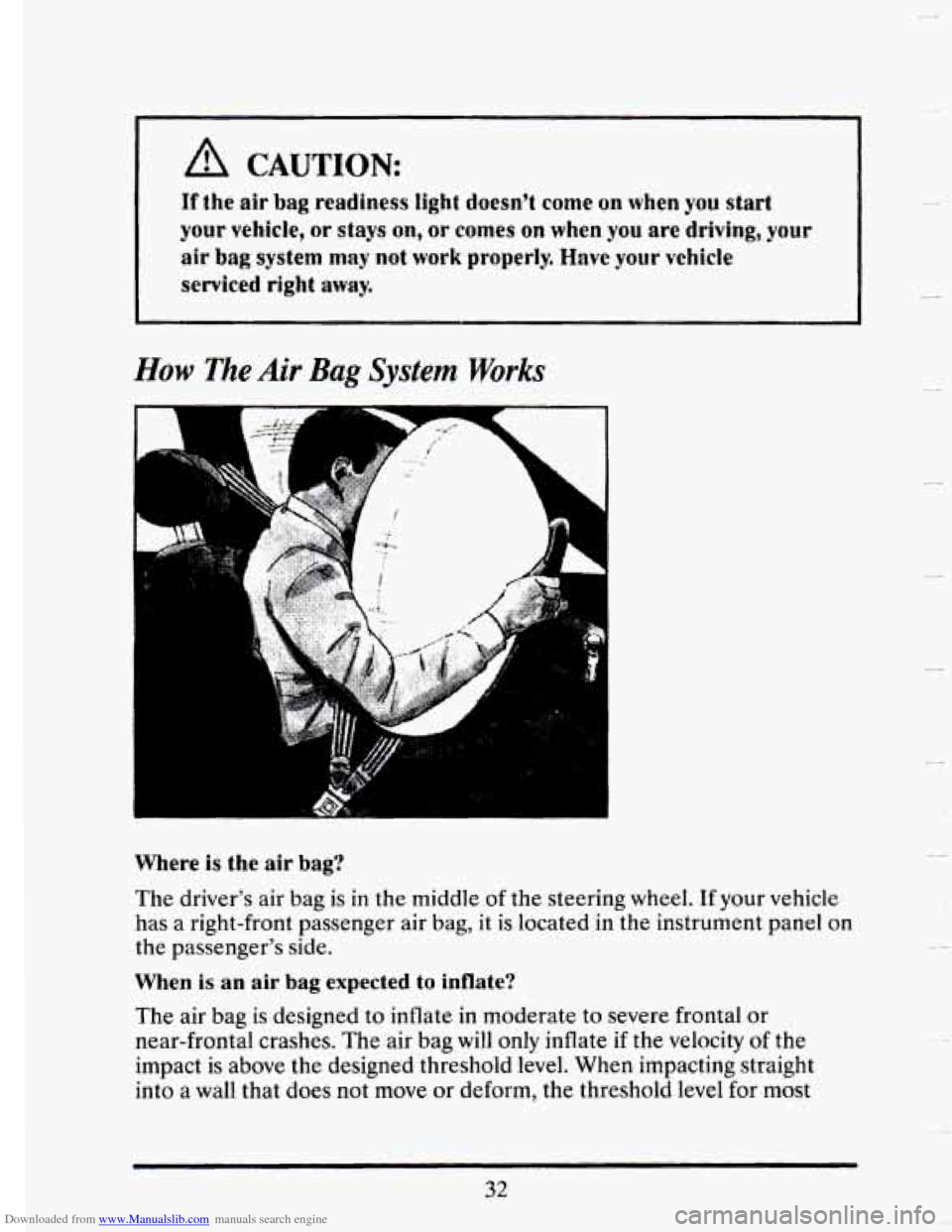
Downloaded from www.Manualslib.com manuals search engine I 1
If the air bag readiness light doesn't come on when you start
your vehicle, or stays on, or comes on when you are driving, your
air bag system may not work properly Have your vehicle
serviced right away
How The Air Bag System Works
..
. ..
Where is the air bag?
The driver's air bag is in the middle of the steering wheel. If your vehicle
has
a right-front passenger air bag, it is located in the instrument panel on
the passenger's side.
When is an air bag expected to inflate?
The air bag is designed to inflate in moderate to severe frontal or
near-frontal crashes.
The air bag will only inflate if the velocity of the
impact
is above the designed threshold level. When impacting straight
into
a wall that does not move or deform, the threshold level for most
32
i
Page 47 of 407
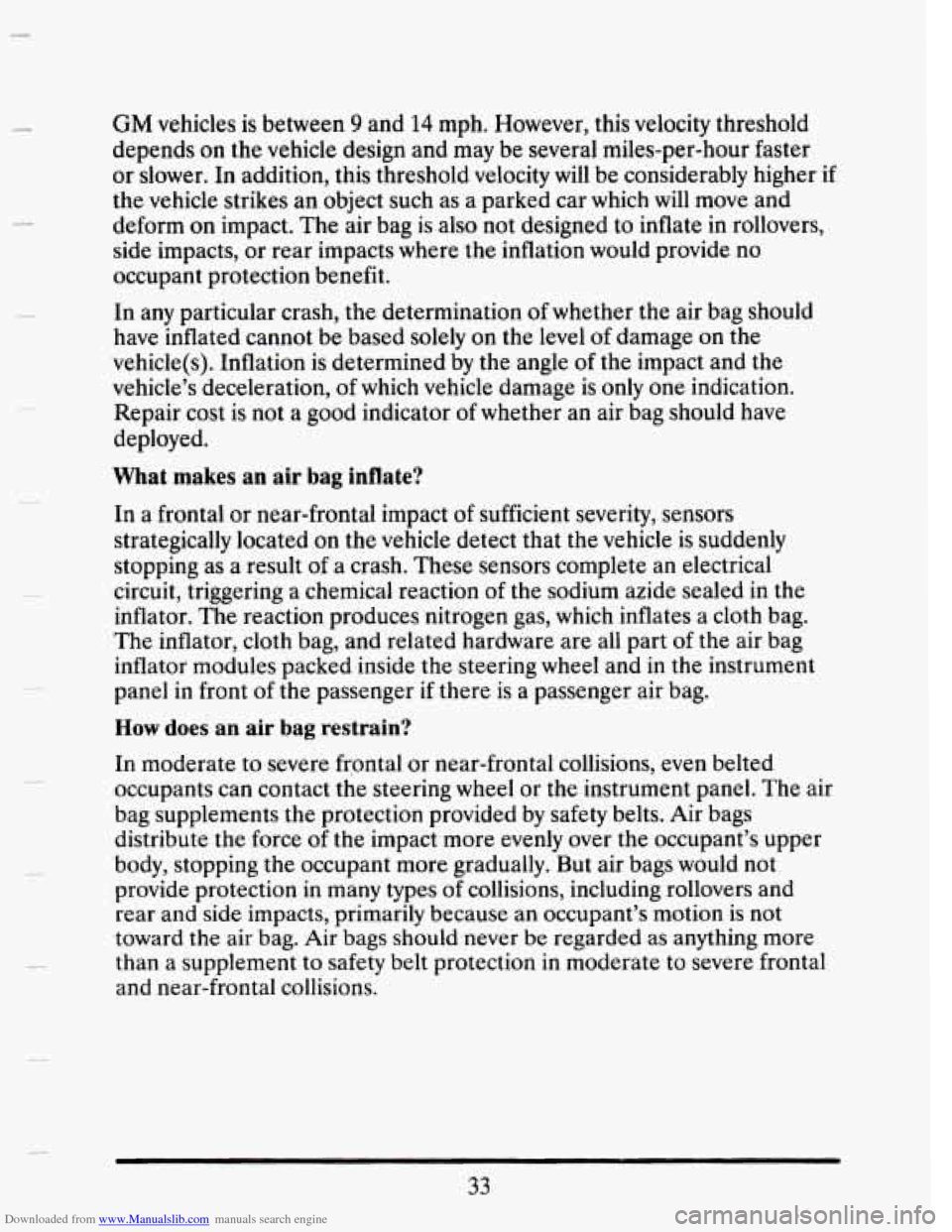
Downloaded from www.Manualslib.com manuals search engine GM vehicles is between 9 and 14 mph. However, this velocity threshold
depends
on the vehicle design and may be several miles-per-hour faster
or slower. In addition, this threshold velocity will be considerably higher
if
the vehicle strikes an object such as a parked car which will move and
deform on impact. The air bag is also not designed to inflate in rollovers,
side impacts,
or rear impacts where the inflation would provide no
occupant protection benefit.
In any particular crash, the determination
of whether the air bag should
have inflated cannot be based solely on the level
of damage on the
vehicle(s). Inflation is determined by the angle
of the impact and the
vehicle’s deceleration,
of which vehicle damage is only one indication.
Repair cost is not a good indicator of whether an air bag should have
deployed.
What makes an air bag inflate?
In a frontal or near-frontal impact of sufficient severity, sensors
strategically located on the vehicle detect that the vehicle
is suddenly
stopping as a result
of a crash. These sensors complete an electrical
circuit, triggering a chemical reaction
of the sodium azide sealed in the
inflator.
The reaction produces nitrogen gas, which inflates a cloth bag.
The inflator, cloth bag, and related hardware are all part of the air bag
inflator modules packed inside the steering wheel and in the instrument
panel
in front of the passenger if there is a passenger air bag.
How does an air bag restrain?
In moderate to severe fr,ontal or near-frontal collisions, even belted
occupants can contact the steering wheel or the instrument panel. The air
bag supplements the protection provided by safety belts. Air bags
distribute the force
of the impact more evenly over the occupant’s upper
body, stopping the occupant more gradually. But air bags would not
provide protection in many types
of collisions, including rollovers and
rear and side impacts, primarily because an occupant’s motion is not
toward
the air bag. Air bags should never be regarded as anything more
than a supplement to safety belt protection
in moderate to severe frontal
and near-frontal collisions.
33
Page 48 of 407
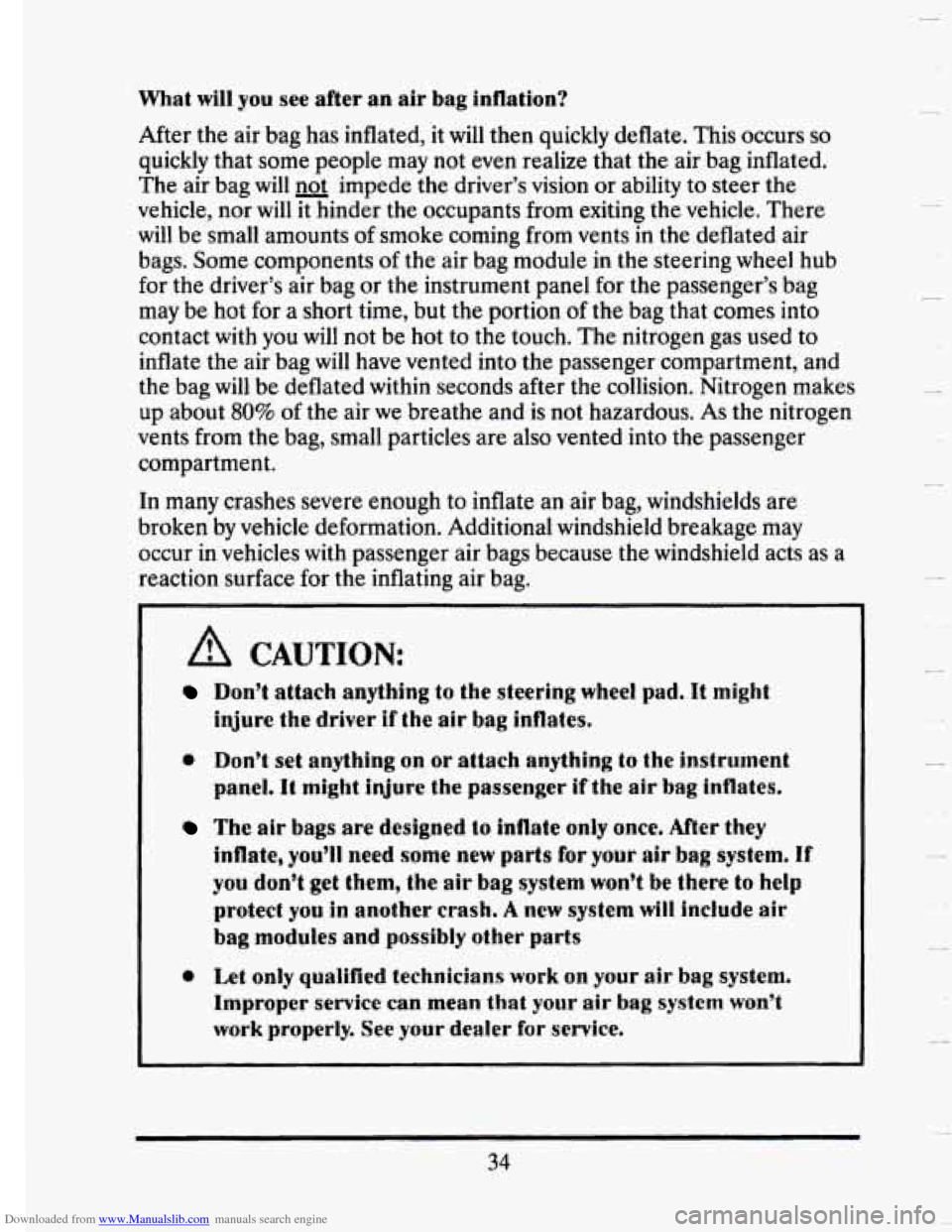
Downloaded from www.Manualslib.com manuals search engine What will you see after an air bag inflation?
After the air bag has inflated, it will then quickly deflate. This occurs so
quickly that some people may not even realize that the air bag inflated.
The air bag will
not impede the driver’s vision or ability to steer the
vehicle, nor will it hinder the occupants from exiting the vehicle. There
will be small amounts
of smoke coming from vents in the deflated air
bags. Some components
of the air bag module in the steering wheel hub
for the driver’s air bag
or the instrument panel for the passenger’s bag
may be
hot for a short time, but the portion of the bag that comes into
contact with
you will not be hot to the touch. The nitrogen gas used to
inflate the air bag
will have vented into the passenger compartment, and
the bag will be deflated within seconds after the collision. Nitrogen makes
up about
80% of the air we breathe and is not hazardous. As the nitrogen
vents from the bag, small particles are also vented into the passenger
compartment.
In many crashes severe enough to inflate an air bag, windshields are
broken
by vehicle deformation. Additional windshield breakage may
occur in vehicles with passenger air bags because
the windshield acts as a
reaction surface for the inflating air bag.
A CAUTION:
Don’t attach anything to the steering wheel pad. It might
injure the driver if the air bag inflates.
@ Don’t set anything on or attach anything to the instrument
panel. It might injure the passenger if the air bag inflates.
The air bags are designed to inflate only once. After they
inflate, you’ll need some new parts for your air bag system. If
yau don’t get them, the air bag system won’t be there to help
protect you in another crash. A new system will include air
bag moduCes and possibly other parts
0 Let only qualified technicians work on your air bag system.
Improper service can mean that your air bag system won’t
work properly. See your dealer for service.
34
c
Page 50 of 407
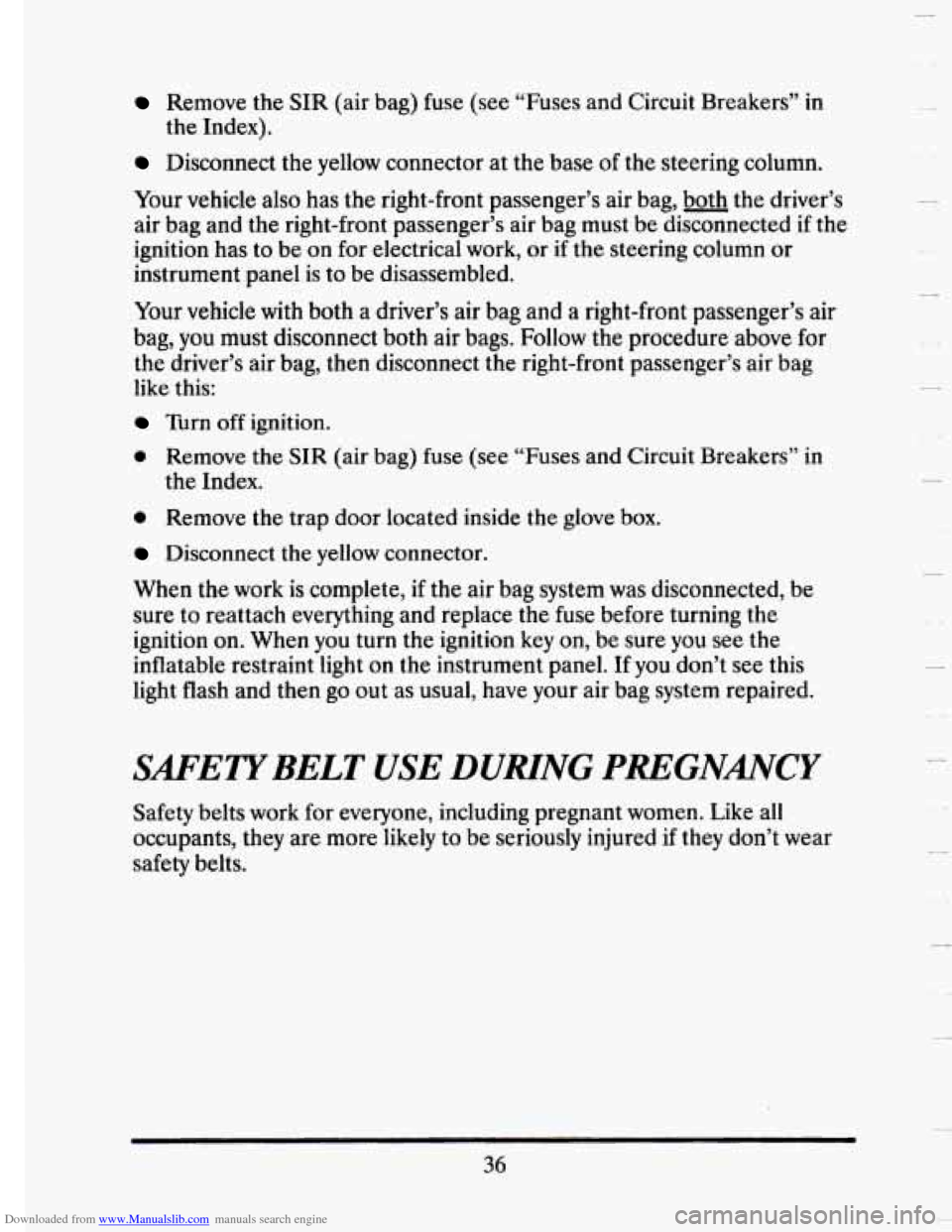
Downloaded from www.Manualslib.com manuals search engine Remove the SIR (air bag) fuse (see “Fuses and Circuit Breakers’’ in
the Index).
Disconnect the yellow connector at the base of the steering column.
Your vehicle
also has the right-front passenger’s air bag, both the driver’s
air bag and the right-front passenger’s air bag must be disconnected
if the
ignition has
to be on for electrical work, or if the steering column or
instrument panel is to be disassembled.
Your vehicle with both
a driver’s air bag and a right-front passenger’s air
bag,
you must disconnect both air bags. Follow the procedure above for
the driver’s
air bag, then disconnect the right-front passenger’s air bag
like this:
Turn off ignition.
0 Remove the SIR (air bag) fuse (see “Fuses and Circuit Breakers” in
the Index.
0 Remove the trap door located inside the glove box.
Disconnect the yellow connector.
When the work
is complete, if the air bag system was disconnected, be
sure to reattach everything and replace the fuse before turning the
ignition on. When you turn the ignition
key on, be sure you see the
inflatable restraint light
on the instrument panel. If you don’t see this
light flash and then go out as usual, have your air bag system repaired.
S’.ETYBELT USE DURING PREGNMCY
Safety belts work for everyone, including pregnant women. Like all
occupants, they
are more likely to be seriously injured if they don’t wear
safety belts.
36
c
Page 77 of 407
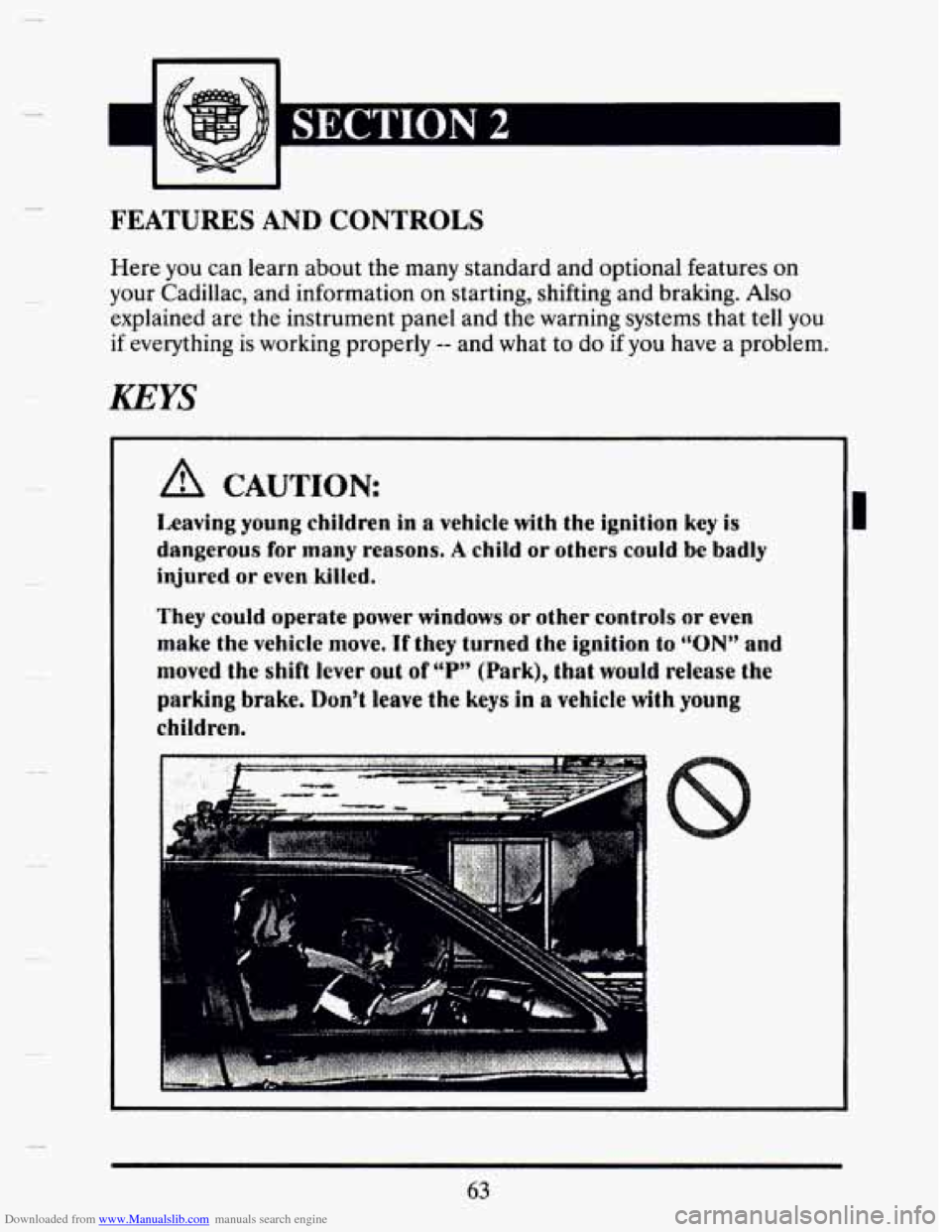
Downloaded from www.Manualslib.com manuals search engine 3N 2
3 3
FEATURES AND CONTROLS
Here you can learn about the many standard and optional features on
your Cadillac, and information on starting, shifting and braking\
.
Also
explained are the instrument panel and the warning systems that tell you
if everything is working properly -- and what to do if you have a problem.
KEYS
A CAUTION:
Lmving young children in a vehicle with the ignition key is
dangerous for many reasons. A child or others could be badly
injured or even killed.
They could operate power windows or other controls or even
make the vehicle move. If they turned the ignition to “ON” and
moved the shift lever out of V’’ (Park), that would release the
parking brake. Don’t leave the keys in a wehide with young
children.
I
63
Page 94 of 407

Downloaded from www.Manualslib.com manuals search engine The other positions let you perform these functions:
ACC: Accessory lets you use things like the radio and the windshield
wipers when the engine
is off. To get into “ACC”, push in the key and turn
it toward
you. Your steering wheel will remain locked, just as it was
before you inserted the key.
OFF: This position lets you turn off the engine but still turn the steering
wheel. It doesn’t lock the steering wheel like “Lock.“ Use ”Off” if WLI
must have your car in motion while the engine is off (for cu:rnlplc*. if >.our
car is being pushed).
NOTICE:
If your key seems stuck in “Imk” rrnd you cdl turn it, be sure
it is all the way in. If it is, then turn the steering wheel left and
fight while you turn the key hard, But turn the key only with
your hand. Using a toooil to force it could break the key or the
ignition switch, If none .of this works, then your vehicle needs
service.
STARTING YOUR ENGINE
Engines start differently. The 8th digit of your Vehicle Identification
Number (VIN) shows
the code letter or number for your engine. You will
find the VIN at the top left
of your instrument panel. (See “Vehicle
Identification Number” in the Index.) Follow the proper steps
to start the
engine.
Move your shift lever to
“P” (Park) or “N” (Neutral). Your engine won’t
start in any other position
-- that’s a safety feature. To restart when you’re
already moving, use
“N” (Neutral) only.
80
H
c
J-r